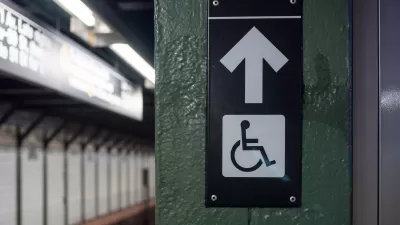Elevator technology developed in the 19th century made the advent of skyscrapers possible. Now that skyscraper construction is rebounding after the recession, can vertical transport systems keep up with developers' and designers' lofty visions?
Tim Catts looks at the latest technologies being developed by the $66 billion elevator industry. "With high-rises in China and Saudi Arabia poised to surpass Dubai’s record 2,717-foot (828-meter) Burj Khalifa, the race to outfit the next generation of super-tall buildings is spurring engineering leaps at Otis, Kone Oyj (KNEBV) and their elevator-making competitors..."
“We’re reinvesting in the skyscraper because the buildings on the drawing board right now are just different,” President Pedro Baranda said in an interview at Otis’s headquarters in Farmington, Connecticut. “Understanding the elevatoring of a very high-rise building can often give you insights into what you can do better at the lower end.”
By utilizing double-deck cars, polyurethane-coated belts, gearless drives, and advanced braking and computerized dispatch systems, elevator companies are pushing the boundaries of what's possible in tall building construction.
“Advances in elevators in the past 20 years are probably the greatest advances we’ve seen in tall buildings,” Council on Tall Buildings and Urban Habitat Chairman Antony Wood said in a telephone interview from Chicago.
FULL STORY: Double-Deck Elevators Rise as Tallest Towers Test Limits

Alabama: Trump Terminates Settlements for Black Communities Harmed By Raw Sewage
Trump deemed the landmark civil rights agreement “illegal DEI and environmental justice policy.”

Planetizen Federal Action Tracker
A weekly monitor of how Trump’s orders and actions are impacting planners and planning in America.

The 120 Year Old Tiny Home Villages That Sheltered San Francisco’s Earthquake Refugees
More than a century ago, San Francisco mobilized to house thousands of residents displaced by the 1906 earthquake. Could their strategy offer a model for the present?

Indy Neighborhood Group Builds Temporary Multi-Use Path
Community members, aided in part by funding from the city, repurposed a vehicle lane to create a protected bike and pedestrian path for the summer season.

Congestion Pricing Drops Holland Tunnel Delays by 65 Percent
New York City’s contentious tolling program has yielded improved traffic and roughly $100 million in revenue for the MTA.

In Both Crashes and Crime, Public Transportation is Far Safer than Driving
Contrary to popular assumptions, public transportation has far lower crash and crime rates than automobile travel. For safer communities, improve and encourage transit travel.
Urban Design for Planners 1: Software Tools
This six-course series explores essential urban design concepts using open source software and equips planners with the tools they need to participate fully in the urban design process.
Planning for Universal Design
Learn the tools for implementing Universal Design in planning regulations.
Clanton & Associates, Inc.
Jessamine County Fiscal Court
Institute for Housing and Urban Development Studies (IHS)
City of Grandview
Harvard GSD Executive Education
Toledo-Lucas County Plan Commissions
Salt Lake City
NYU Wagner Graduate School of Public Service




























